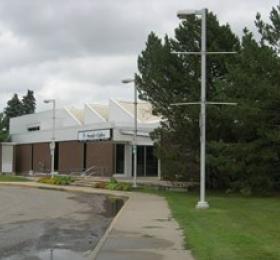Mendel Building and Civic Conservatory
- Designated
Description of the Historic Place
The Mendel Building and Civic Conservatory is a large concrete, masonry and glass building located at 950 Spadina Crescent East along the banks of the South Saskatchewan River. Built in 1964, the Mendel Building and Civic Conservatory is an excellent example of the Modernist architectural style.
This historic place was designated as a Municipal Heritage Property in 2018. the designation applies to the exterior of the building and the interior lobby.
Heritage Value
The design for the Mendel Building and Civic Conservatory was the result of a nation-wide design competition. The building was to include an art exhibit and instruction areas, areas for outdoor display, gallery areas, and the conservatory. The winning design was submitted by Blankstein, Coop, Gilmour, and Hanna of Winnipeg, Manitoba. The building’s architecture exhibits the classic modernist attributes of light, order, and open space planning. The building features no ornamentation, large pure spatial volumes, and exhibits transparency with the exterior landscape and framed views of the river. The building has a unique ‘saw tooth’ roof structure which challenged the roofing technology available at the time.
The main level of the building contains the lobby, conservatory, and museum space. The lobby and museum section of the building features brick walls, skylights, and a reinforced concrete roof, while the conservatory portion of the building is made entirely of glass with a roof that has six pyramid-shaped glass domes. The lower level has a 250 seat auditorium, art workshop studio, and a work area for the conservatory. An addition was completed on the north side of the building in 1975; however the Mendel building continues to retain much of its original character.
The heritage value of the Mendel building also lies in its association with Fred S. Mendel, a local industrialist who was instrumental in establishing the building. Mendel and his family emigrated from Germany to Saskatoon in 1939 as a result of Nazi persecution. Mendel’s family had been in the meatpacking business for generations, and when he came to Saskatoon he purchased an abandoned co-operative packing plant and established a company called the Intercontinental Packers in 1940. In the following years, Mendel opened further meat-packing plants in Regina, Red Deer, and Vancouver. By the end of World War II, Intercontinental Packers had plants across Western Canada and Australia, and by 1975, Intercontinental Packers was the fourth largest meat-packing operation in Canada.
Mendel was not only an industrialist, but also an art collector and art enthusiast. In the early 1960s, Fred Mendel donated $175,000 for the construction of a civic art gallery and conservatory. His contribution was matched by the province, with a suitable site provided by the City of Saskatoon. After much discussion about the location of the art gallery and conservatory, the location along Spadina Crescent, adjacent to the South Saskatchewan River, was chosen. The Mendel Art Gallery and Civic Conservatory officially opened on October 16, 1964. The first curator-director of the gallery was John E. Climer, and in its first year the gallery saw approximately 300,000 visitors.
The Mendel Building and Civic Conservatory became one of the major collecting art galleries in Saskatchewan. In 1965, Fred Mendel donated thirteen paintings to the Gallery, including paintings by the Group of Seven which became the nucleus of the Gallery’s collection. Over the years, by donation and acquisition, the collection had grown to include many works by Saskatchewan, Canadian and international artists in a variety of media and styles.
To accommodate its ever increasing need for space, the Mendel Art Gallery vacated its existing space in 2015, and will move to a new location in 2017 as the Remai Modern Art Gallery of Saskatchewan. The Mendel Building will continue to be used for the Civic Conservatory, and will eventually be the new location of the Children’s Discovery Museum.
Source: City of Saskatoon Built Heritage Database
Character Defining Elements
Key elements which contribute to the heritage value of this historic resource include:
- Its Modernist style of architecture, evident in; its exterior brick façade (including the 1975 addition), its free standing masonry walls; its saw-tooth portion of the roof; its interior lobby design with open site lines; its staircase; and the louvered ceiling in the former gallery space.
- The elements of the Conservatory’s exterior, including its glass façade, pyramid-shaped glass domes, concrete columns, and signage on the south façade.
- Those elements that relate to the building’s cultural significance, including its outdoor garden at the conservatory, the donor wall and the siting of the building in relation to the Riverbank.

